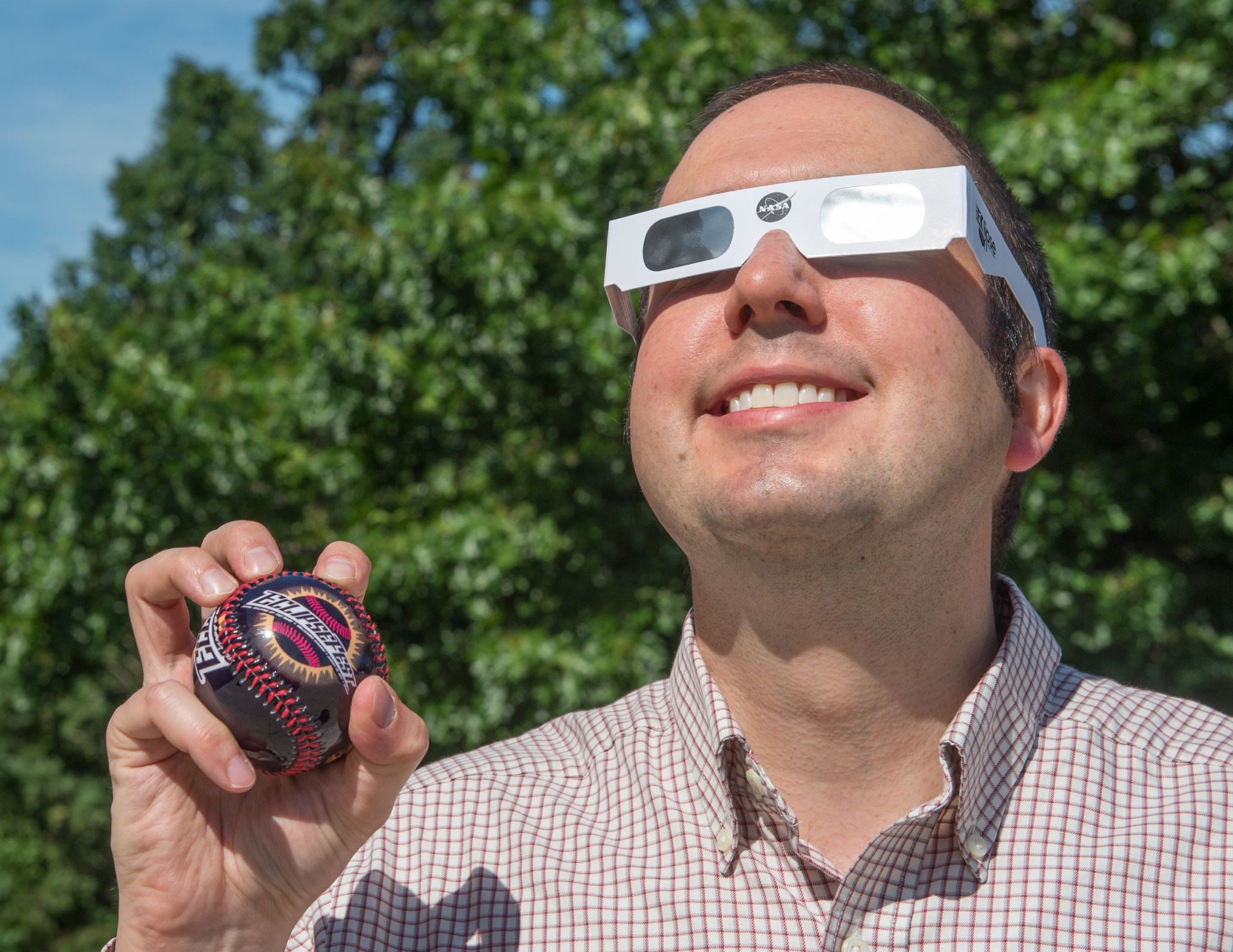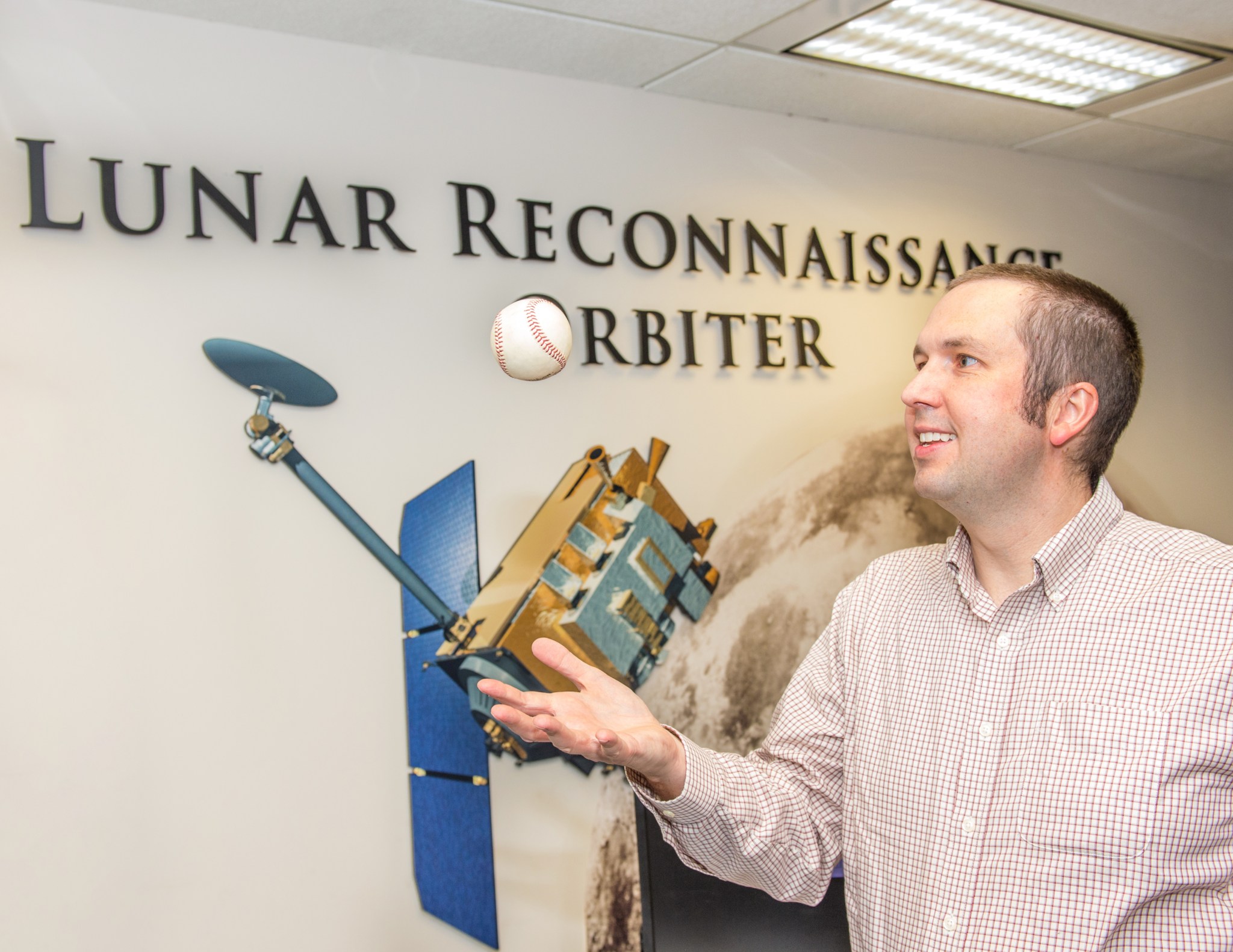As deputy project scientist for NASA’s Lunar Reconnaissance Orbiter, Noah Petro spends a lot of time thinking about a particular, off-white sphere that soars through the sky. Most of the time that orb is the moon, but this summer it’s an entirely different ballgame – several of them, in fact.
NASA scientist and lunar heavy hitter Petro loves the moon. He also loves baseball. Through his efforts, NASA will step up to bat with the Salem-Keizer Volcanoes at “EclipseFest: Total Eclipse of the Park!” in Oregon, as well as at two other minor league stadiums, to experience baseball’s first-ever eclipse delay.
Take me out to the eclipse game!
On Aug. 21, 2017, the moon will be caught in a rundown between Earth and the sun. This cosmic triple play among sun, Earth and moon will produce the first American coast-to-coast solar eclipse since 1918 (the last time Boston and the Cubs matched up in the World Series).
The darkest part of the moon’s shadow, the umbra, will pass across the entire continental United States, in a 70-mile-wide corridor running from Oregon to South Carolina, the path of totality. Although a total solar eclipse will only be visible within this strip, everyone in the continental U.S. can be a fan on the 21st, as even those outside the path of totality will see a partial eclipse.
Petro saw an opportunity to take science out to the ballgame. “The path of totality misses all major league baseball stadiums; however, it does pass over six minor league baseball stadiums, four of which will be playing games that day,” he said. “Out of left field, I cold-emailed each of the teams to let them know about the eclipse and asked if they wanted NASA participation. I am now thrilled to be involved with eclipse planning with three of these teams.”
NASA will participate in eclipse events associated with minor league baseball games in the Salem-Keizer area of Oregon (where Petro will be); Idaho Falls, Idaho; and Charleston, South Carolina.
“We will attempt a transcontinental double header with the Charleston RiverDogs,” Petro said. “The game in Oregon will end about the time the game in South Carolina starts, so we are hoping to connect the events. The eclipse will occur, locally, during the Oregon game and before the S.C. game.”
“Hey, Mr. Moon! Batter up!”
The Salem-Keizer Volcanoes in northwestern Oregon stepped up to the plate and responded to Petro. Right off the bat, they were planning a four-day “EclipseFest: Total Eclipse of the Park,” the brainchild of Volcanoes’ owners Jerry and Lisa Walker. Jerry’s brother Jim, a retired physics professor, had given the team a “heads up” on the path of the eclipse passing directly over the Volcanoes’ stadium.
The team designed a special souvenir EclipseFest baseball and eclipse-themed uniforms. The team is providing solar-viewing glasses for fans in attendance.
“This is very unique,” Walker said. “We’re providing not just a chance to experience the eclipse but also to experience the first eclipse delay in baseball history.”
The Volcanoes game, which will have its radio feed broadcast online (and a portion streamed as part of NASA’s eclipse coverage), will start at 9:35 a.m. local (Pacific) time. The game will stop after the first inning of the game for the eclipse, which will pass overhead at about 10:17 a.m. The delay will last about 30 minutes to give everyone time to get ready for totality, the moments of darkest shadow lasting about two minutes.
On occasion, rain, fog or even bees (in September 2016 during an Angles-Blue Jays game) have delayed a professional ballgame. But, according to Petro, this is the first time one will be delayed by an eclipse. The closest similar event was in February 1980, when a cricket match in India was postponed a day to avoid playing during a partial eclipse.
“I have always loved baseball,” said Petro. “For me, the eclipse is the perfect intersection of my passions, my family, baseball and the moon. I’m over the moon and back about this event.”
Petro, accompanied by his wife and two young children, and a team of NASA scientists and outreach specialists will speak about the science behind the eclipse and how to safely view it. NASA will also have a booth at EclipseFest with educational materials about NASA’s moon-circling Lunar Reconnaissance Orbiter mission and the moon’s literally central role in the eclipse.
LRO, launched in June 2009, is a mission whose seven different instruments are mapping the surface of the moon and its surrounding environment. LRO has has produced the highest quality, global topographic map of any planetary body, i.e., the moon. LRO continues to hit home runs, producing a large volume of data. LRO will also be an eclipse spectator by attempting to view, from space, the moon’s shadow on Earth’s surface (a feat LRO achieved before in 2012).
Play ball!
“This is an eclipse that people all across American will see,” Petro said. “The tie-in to American’s favorite pastime couldn’t make for a more unique and fun environment to view the eclipse. What I’m most interested in seeing is the players standing on the field, surrounded by a ballpark of 5,000 fans, including my family, looking up at the eclipsed sun. To quote Yogi Berra, ‘You can observe a lot by just watching.’”
No doubt, Petro is going to have a ball during this grand-slam event. And it will be a whole new ballgame for NASA too.
Additional NASA eclipse resources and events can be found at eclipse2017.nasa.gov.
Elizabeth M. Jarrell
NASA Goddard Space Flight Center






























